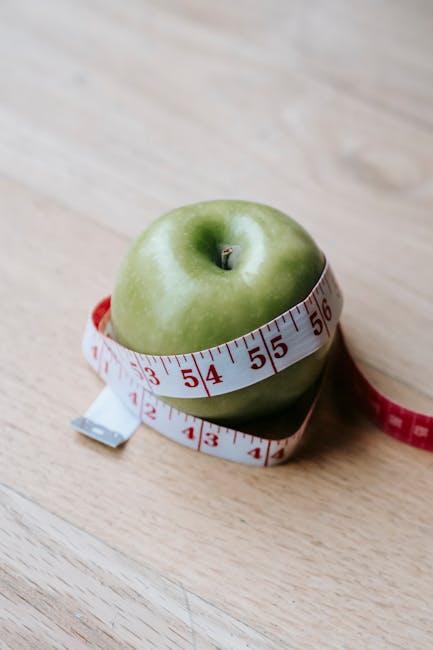In a world where supersized meals and all-you-can-eat buffets beckon at every corner, the art of portion control often gets lost in the shuffle. Imagine savoring a meal where each bite is a mindful experience, contributing not just to the satisfaction of your taste buds, but also to the well-being of your body. The concept of portion control isn’t about deprivation; it’s about finding balance. This delicate dance between appetite and nutrition holds the key to maintaining a healthy weight, a goal that seems ever elusive in our fast-paced lives. As we delve into the importance of portion control, we will uncover how this simple yet powerful practice can transform our relationship with food, helping us to lead healthier, more fulfilling lives.
Understanding Portion Distortion and Its Impact on Health
In today’s fast-paced world, it’s easy to fall prey to portion distortion—the gradual increase in portion sizes that can skew our perception of what constitutes a “normal” amount of food. This phenomenon can have serious repercussions on our health, leading to unintended weight gain and associated health issues. Recognizing and addressing portion distortion is crucial for anyone aiming to maintain a healthy weight.
- Visual Cues: Understanding standard serving sizes can help. For instance, a serving of meat should be the size of a deck of cards, while a serving of pasta should resemble a tennis ball.
- Mindful Eating: Pay attention to hunger and fullness cues. Eating slowly allows your brain to register when you’re full, reducing the likelihood of overeating.
- Pre-Portioning: Instead of eating directly from large packages, serve yourself a reasonable amount to avoid consuming excess.

Practical Tips for Measuring and Controlling Portions
One of the most effective ways to manage your portions is to be mindful of the size of your serving dishes. Opt for smaller plates, bowls, and cups to naturally limit the amount of food you consume. It might sound trivial, but studies have shown that using smaller dishware can trick your brain into feeling satisfied with less food. Additionally, try to use measuring cups and spoons to serve your meals, especially for calorie-dense foods like pasta, rice, and nuts.
- Divide your plate: Follow the MyPlate method by filling half of your plate with vegetables and fruits, a quarter with lean proteins, and the remaining quarter with whole grains.
- Pre-portion snacks: Instead of eating straight from the bag, divide snacks into individual portions ahead of time.
- Slow down: Eating slowly can help you recognize when you are full, reducing the likelihood of overeating. Try to savor each bite and chew thoroughly.
Being aware of portion sizes can also be facilitated by reading nutrition labels. Pay attention to the serving size listed and compare it to the amount you actually eat. This can help you make more informed decisions about your intake and ensure that you are not consuming more than you realize.

Mindful Eating: Strategies to Avoid Overeating
One of the most effective strategies to prevent overeating is practicing mindful eating. This involves being fully present during meals and paying attention to the taste, texture, and aroma of your food. By savoring each bite, you can better recognize when you are full and avoid consuming unnecessary calories. Here are some tips to help you eat more mindfully:
- Slow Down: Take your time to chew thoroughly and enjoy each mouthful. This gives your brain enough time to register feelings of fullness.
- Eliminate Distractions: Turn off the TV, put away your phone, and focus solely on your meal. This helps you stay in tune with your body’s hunger and satiety signals.
- Portion Your Plate: Serve smaller portions to start with, and only go back for seconds if you are genuinely still hungry.
- Listen to Your Body: Pay attention to your hunger cues and stop eating when you feel satisfied, not stuffed.
Balancing Nutrients: Creating Well-Portioned, Nutrient-Dense Meals
A well-portioned, nutrient-dense meal is the cornerstone of a balanced diet. The key to achieving this balance lies in selecting foods that provide essential nutrients without excessive calories. Consider incorporating a variety of food groups, such as:
- Lean Proteins: Think chicken, fish, tofu, or legumes. These options help build and repair tissues while keeping you satiated.
- Whole Grains: Opt for quinoa, brown rice, or whole-wheat pasta. These complex carbohydrates provide sustained energy and are rich in fiber.
- Colorful Vegetables: Include a rainbow of veggies like spinach, bell peppers, and carrots to ensure a wide range of vitamins and minerals.
- Healthy Fats: Avocados, nuts, and olive oil can enhance the flavor of your meals while offering heart-healthy benefits.
Balancing these components not only supports weight management but also enhances overall well-being. By focusing on nutrient density, you ensure that every bite contributes to your health goals, making it easier to maintain a healthy weight without feeling deprived.





